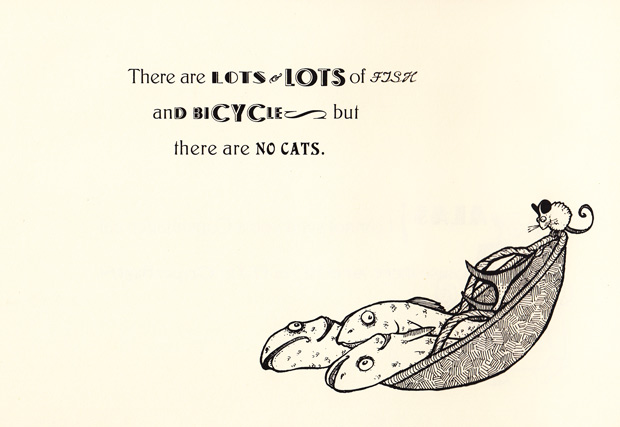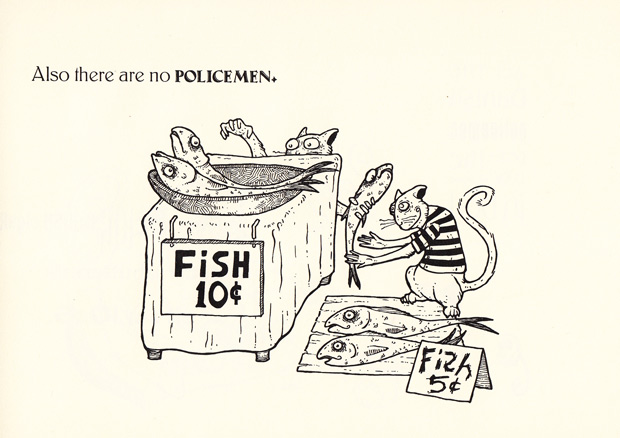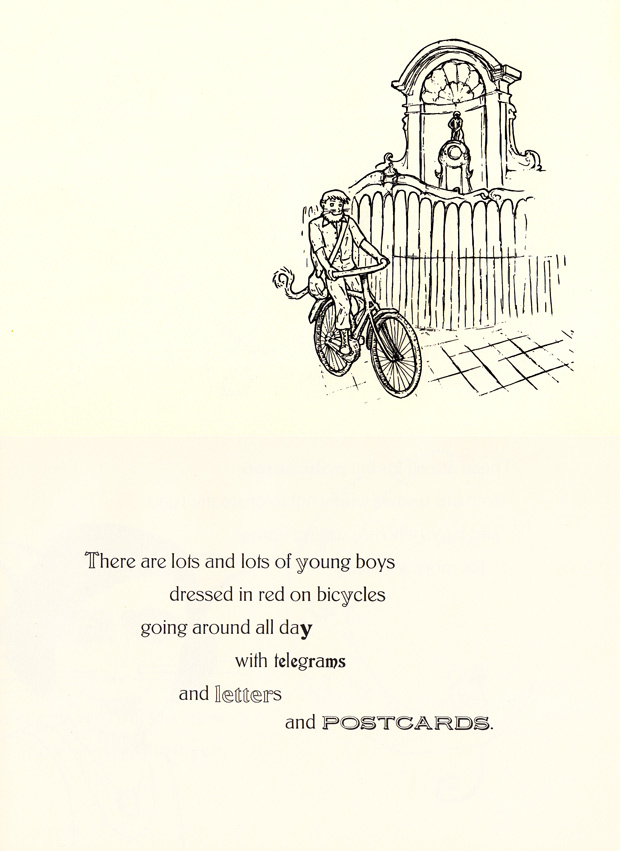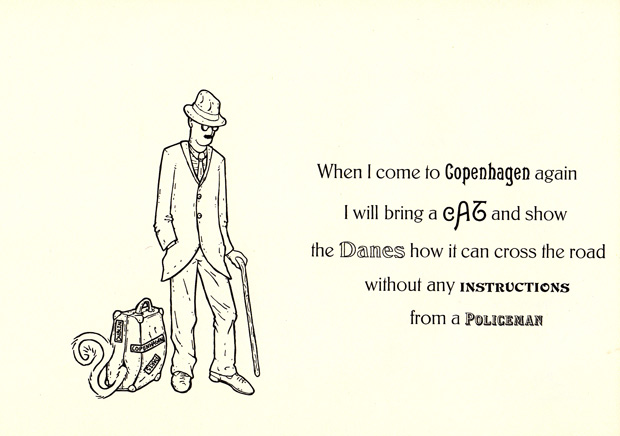James Joyce's "Ulysses" chronicles a single day—June 16th 1906—in the life of Leopold Bloom. When published, government officials declared the book to be “unreadable, unquotable and unreviewable”. British war censors became convinced that it was written in spy code and it was confiscated and burned on both sides of the Atlantic.http://econ.st/1J13n2h
The Cats of Copenhagen: Delightful Recently Discovered Children’s Story by James Joyce
by Maria PopovaA charming, irreverent picture-book based on Joyce’s letters to his only grandson.
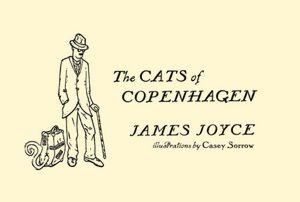 As a connoisseur of little-known children’s books by famous authors of literature for grown-ups, I already knew that James Joyce had penned the charming 1965 picture-book The Cat and the Devil, based on a 1936 letter to his most beloved audience, his grandson Stephen. So imagine my delight at the news of a posthumous Joyce children’s release, The Cats of Copenhagen (public library) — a never-before-published short story also based on a letter to Stephen.
As a connoisseur of little-known children’s books by famous authors of literature for grown-ups, I already knew that James Joyce had penned the charming 1965 picture-book The Cat and the Devil, based on a 1936 letter to his most beloved audience, his grandson Stephen. So imagine my delight at the news of a posthumous Joyce children’s release, The Cats of Copenhagen (public library) — a never-before-published short story also based on a letter to Stephen.In August 1936, Joyce mailed his grandson “a little cat filled with sweets” — a sort of candy mule designed to outwit Stephen’s parents. “Alas! I cannot send you a Copenhagen cat because there are no cats in Copenhagen,” Joyce wrote Stephen from Denmark a month later in a wonderfully playful, mischievous letter that unfolded into a whimsical tale. The short story, illustrated by Casey Sorrow in a style reminiscent of Edward Gorey and beautifully typeset by book artist Michael Caine, was only recently rediscovered and makes an offbeat but characteristically masterful addition to Joyce’s well-known body of work.
The preface speaks to Joyce’s love of cats, a kind of bonding agent for him and his grandson — because, after all, what great writer doesn’t know the creative power of a cat:
Exquisite, minuscule, and with strong, almost anarchic subtext, The Cats of Copenhagen is a slightly younger twin sister to The Cat and the Devil, the only other known example of James Joyce’s writing a story for young children. Both works, written within a few weeks of each other, are in letters posted to stephen James Joyce, his only grandchild. Clearly, cats were a common currency between them: cats, and their common need to have somebody around to help them cross the road.[…]Like many otherwise sensible people, James Joyce detested, even loathed, dogs; but he thought the world of cats. In the first chapter of Ulysses in which Leopold Bloom appears, the very first conversation is between a hungry feline and a kind-hearted Bloom.
The Cats of Copenhagen is an absolute treat — highly recommended.
Born #onthisday in 1882: author James Joyce. Richard Hamilton spent fifty years visualising his love of Joyce’s great modernist masterpiece, Ulysses, which recounts Leopold Bloom wandering around Dublin http://ow.ly/Ia9T3
James Joyce, 1882-1941
Biographical note
Irish expatriate author of the 20th century. He is best known for his landmark novel Ulysses [1922] and its controversial successor Finnegans Wake [1939], as well as the short story collection Dubliners [1914] and the semi-autobiographical novel A Portrait of the Artist as a Young Man [1916].Although he spent most of his adult life outside Ireland, Joyce's psychological and fictional universe is firmly rooted in his native Dublin, the city which provides the settings and much of the subject matter for all his fiction. In particular, his tempestuous early relationship with the Irish Roman Catholic Church is reflected through a similar inner conflict in his recurrent alter ego Stephen Dedalus.
Works
June 16,
Bloomsday: James Joyce'sUlysses follows Leopold Bloom through this one day of his life (1904)
A Reader's Guide to JamesJoyce by W. Y. Tindall
2004 莊信正是印第安那大學比較文學博士,是研究英國作家喬伊斯及其作品《尤利西斯》的專家。最近, 他將近年來所寫關於《尤利西斯》的長文短章, 交九歌出版社結集為《面對尤利西斯》,並加註了喬伊斯的年譜、 著作概說等,為這部小說及作者提供了更詳細且全面的資料。
對於能有機會回台灣教學,滿心歡喜,他說:「以前回台灣多半是擔任文學獎評審,時間不長, 這回可以有足夠的時間逛書店,和文學界的朋友談文論藝, 真可說是如魚得水啊!」
「這本書的書名《My Brother's Keeper─James Joyce's Early Years》,直接源於聖經,但故事卻是反面的例 證。那是聖經中頭一對兄弟:該隱和亞伯的悲劇故事,該隱因為敬拜神的事遷怒他的兄弟,把亞伯殺了,神來找該隱談話,問他弟弟哪去了,但當時該隱不但沒有悔 意,還相當傲慢,他頂了一句話:「Am I my brother's keeper?」〈我豈是看守我兄弟的?〉」(昆布:布魯姆日百年─談一位被遺忘的守護者 時間:2004-06-26 http://www.ylib.com/class/talkout/TalkShow.asp?object=req&no=654))
昨夜讀Joyce詩集(中文),其中收不少他的打油詩,
雙關與很多,如用磅指詩人 Pound;寫Made Oscar Wild影射O. Wilde;"a man with my style"—style既指風格(Mode of expressing thought in language, whether oral or written; especially, such use of language in the expression of thought as exhibits the spirit and faculty of an artist; choice or arrangement of words in discourse; rhetorical expression. Mode of presentation, especially in music or any of the fine arts; a characteristic of peculiar mode of developing in idea or accomplishing a result.)也指"(古)筆"( Hence, anything resembling the ancient style in shape or use. Specifically: (a) A pen; an author's pen. --Dryden.)
又
joyce 簽名喜歡將JJ倒立…
他給e. pound詩引但丁「1個地獄已足夠」還未找到出處...
留言:
典故與應用:亞典娜、密涅瓦、貓頭鷹、嘗試
Athene可能是希臘時代之前即有的神祇,有時稱為Pallas Athen(理由不詳),而Pallas有兩義:一為maiden(年輕女子),一為brandiser((武器的)揮舞;炫耀者)
She was par excellence a war-goddess, and is most frequently represented in art as armed, but in addition she was the patroness of of all urban arts and crafts, especially spinning and weaving, and so ultimatelt the personification of wisdom..我對於上句:「司掌戰爭、紡織及家庭工藝、最終為「智慧之人格具體化」的說法很感興趣。」
【英文抄自Oxford Dictionary of Classical Literature的Athene詞條,好事者應以它查圖片。】
The Works of James Joyce ( Wordsworth Poetry Library)
Exiles and poetry[edit]
Main articles: Pomes Penyeach and Chamber Music (book)
Despite early interest in the theatre, Joyce published only one play, Exiles, begun shortly after the outbreak of World War I in 1914 and published in 1918. A study of a husband and wife relationship, the play looks back to The Dead (the final story in Dubliners) and forward to Ulysses, which Joyce began around the time of the play's composition.
Joyce also published a number of books of poetry. His first mature published work was the satirical broadside "The Holy Office" (1904), in which he proclaimed himself to be the superior of many prominent members of the Celtic revival. His first full-length poetry collection Chamber Music (referring, Joyce joked, to the sound of urine hitting the side of a chamber pot) consisted of 36 short lyrics. This publication led to his inclusion in the Imagist Anthology, edited by Ezra Pound, who was a champion of Joyce's work. Other poetry Joyce published in his lifetime includes "Gas From A Burner" (1912), Pomes Penyeach (1927) and "Ecce Puer" (written in 1932 to mark the birth of his grandson and the recent death of his father). It was published by the Black Sun Press in Collected Poems(1936).
ジョイスはまた数冊の詩集も出版している。習作を除くとジョイスが最初に発表した詩作品は痛烈な諷刺詩「検邪聖省」("The Holy Office"、1904年)であり、この作品によってジョイスはケルト復興運動(Celtic Revival)の著名なメンバーたちの中で名を上げた。1907年に出版された最初のまとまった詩集『室内楽』("Chamber Music"、ジョイス曰く「尿瓶(chamber pot)に当たる小便の音のこと」)は36篇からなる。この本はエズラ・パウンドの編集する「Imagist Anthology」に加えられ、パウンドはジョイス作品の最も強力な擁護者となった。ジョイスが生前に発表した他の詩には「火口からのガス」("Gas From A Burner"、1912年)、詩集『ポームズ・ペニーチ』("Pomes Penyeach"、1927年)、"Ecce Puer"(1932年、孫の誕生と父の死を記したもの)などがあり、これらは1936年に『詩集』("Collected Poems")として一冊にまとめられた。
- 1907年『室内楽』("Chamber Music"、詩集)
- 1927年『ポームズ・ペニーチ』("Pomes Penyeach"、詩集)
喬伊斯也出版了相當數量的詩集。他的第一部成熟的詩作是具有諷刺風格的《神聖的辦公室》,出版於1904年。在這部作品中喬伊斯聲稱自己比愛爾蘭文藝復興運動中的很多大師都要高明。喬伊斯的第一部大型詩集則是《室內樂》,裡面收錄了36首抒情詩。喬伊斯因這部詩集的出版而被艾茲拉·龐德列入意象派詩人之列。而龐德本人在隨之而來的十幾年裡也成了喬伊斯最忠誠的支持者之一。1936年出版的《詩歌選集》收錄了喬伊斯晚年的一些詩作。
The Works of James Joyce ( Wordsworth Poetry Library) 1993
****
Carl Jung Writes a Review of Joyce’sUlysses and Mails It To The Author (1932)
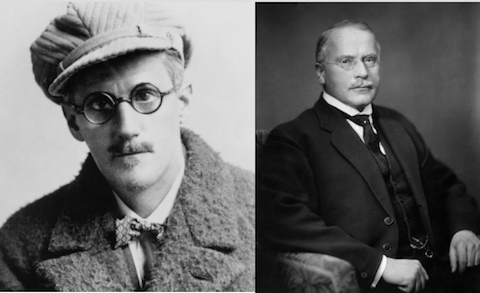
Feelings about James Joyce’s Ulysses tend to fall roughly into one of two camps: the religiously reverent or the exasperated/bored/overwhelmed. As popular examples of the former, we have the many thousand celebrants of Bloomsday—June 16th, the date on which the novel is set in 1904. These revelries approach the level of saints’ days, with re-enactments and pilgrimages to important Dublin sites. On the other side, we have the reactions of Virginia Woolf, say, or certain friends of mine who left wry comments on Bloomsday posts about picking up something more “readable” to celebrate. (A third category, the scandalized, has more or less died off, as scatology, blasphemy, and cuckoldry have become the stuff of sitcoms.) Another famous reader, Carl Jung, seems at first to damn the novel with some faint praise and much scathing criticism in a 1932 essay for Europäische Revue, but ends up, despite himself, writing about the book in the language of a true believer.
A great many readers of Jung’s essay may perhaps nod their heads at sentences like “Yes, I admit I feel I have been made a fool of” and “one should never rub the reader’s nose into his own stupidity, but that is just what Ulysses does.” To illustrate his boredom with the novel, he quotes “an old uncle,” who says “’Do you know how the devil tortures souls in hell? […] He keeps them waiting.’” This remark, Jung writes, “occurred to me when I was plowing through Ulysses for the first time. Every sentence raises an expectation which is not fulfilled; finally, out of sheer resignation, you come to expect nothing any longer.” But while Jung’s critique may validate certain hasty readers’ hatred of Joyce’s nearly unavoidable 20th century masterwork, it also probes deeply into why the novel resonates.
For all of his frustration with the book—his sense that it “always gives the reader an irritating sense of inferiority”—Jung nonetheless bestows upon it the highest praise, comparing Joyce to other prophetic European writers of earlier ages like Goethe and Nietzsche. “It seems to me now,” he writes, “that all that is negative in Joyce’s work, all that is cold-blooded, bizarre and banal, grotesque and devilish, is a positive virtue for which it deserves praise.” Ulysses is “a devotional book for the object-besotted white man,” a “spiritual exercise, an aesthetic discipline, an agonizing ritual, an arcane procedure, eighteen alchemical alembics piled on top of one another […] a world has passed away, and is made new.” He ends the essay by quoting the novel’s entire final paragraph. (Find longer excerpts of Jung’s essay hereand here.)
Jung not only wrote what may be the most critically honest yet also glowing response to the novel, but he also took it upon himself in September of 1932 to send a copy of the essay to the author along with the letter below.Letters of Note tells us that Joyce “was both annoyed and proud,” a fittingly divided response to such an ambivalent review.
Dear Sir,Your Ulysses has presented the world such an upsetting psychological problem that repeatedly I have been called in as a supposed authority on psychological matters.Ulysses proved to be an exceedingly hard nut and it has forced my mind not only to most unusual efforts, but also to rather extravagant peregrinations (speaking from the standpoint of a scientist). Your book as a whole has given me no end of trouble and I was brooding over it for about three years until I succeeded to put myself into it. But I must tell you that I’m profoundly grateful to yourself as well as to your gigantic opus, because I learned a great deal from it. I shall probably never be quite sure whether I did enjoy it, because it meant too much grinding of nerves and of grey matter. I also don’t know whether you will enjoy what I have written about Ulysses because I couldn’t help telling the world how much I was bored, how I grumbled, how I cursed and how I admired. The 40 pages of non stop run at the end is a string of veritable psychological peaches. I suppose the devil’s grandmother knows so much about the real psychology of a woman, I didn’t.Well, I just try to recommend my little essay to you, as an amusing attempt of a perfect stranger that went astray in the labyrinth of your Ulysses and happened to get out of it again by sheer good luck. At all events you may gather from my article what Ulysses has done to a supposedly balanced psychologist.With the expression of my deepest appreciation, I remain, dear Sir,Yours faithfully,C. G. Jung
With this letter of introduction, Jung was “a perfect stranger” to Joyce no longer. In fact, two years later, Joyce would call on the psychologist to treat his daughter Lucia, who suffered from schizophrenia, a tragic story told in Carol Loeb Schloss’s biography of the novelist’s famously troubled child. For his care of Lucia and his careful attention to Ulysses, Joyce would inscribe Jung’s copy of the book: “To Dr. C.G. Jung, with grateful appreciation of his aid and counsel. James Joyce. Xmas 1934, Zurich.”
via Letters of Note
Related Content:
Josh Jones is a writer and musician based in Durham, NC. Follow him at @jdmagness
****2004 都柏林人、藝術家、《尤利西斯》
尤里西斯百年慶 喬埃斯早餐待客:體驗一下「色、香、味」俱全的喬埃斯!
【【2004/05/01 民生報;編譯張佑生/路透都柏林二十九日電】】
今年是愛爾蘭大文豪喬埃斯的現代主義巨著「尤里西斯」
問世100周年紀念。主辦單位計畫推出1萬人份的免費早餐,菜單包括上萬份的香腸、豬腰、麵包捲、1萬個蕃茄和500公斤奶油,這些都是小說主角布魯姆推崇的食物。差別在於活動日期比「布魯姆日」6月16日提前3天舉辦,因為6月13日是周日,動用50名廚師比較方便。
相關活動將進行到8月31日,詳情見www.rejoycedublin2004.com網站。
【這些食物的出處、翻譯都待查】
【布魯姆節百年慶典(Bloomsday Centenary Festival);Rejoyce Dublin 是來都柏林歡樂、喜聚;Rejoyce 為re-Joyce (諧音rejoice,to feel or show great happiness about something)。該網站日文的翻譯遠比中文的正確得多。這Joyce,翻譯成「喬埃斯」,網站中為「•喬伊絲」,翻譯者似乎有點「陰陽」陌生……】
We welcome you to the official Rejoyce Dublin 2004 Bloomsday Centenary Festival web site. Here you will find the most up to date information on all festival events.
歡迎您來到ReJoyce Dublin 2004 布魯姆節百年慶典的官方網站。在這裏,您能找到有關全部慶典活動的最新資訊。
For millions of people, June 16 is an extraordinary day. On that day in 1904, Stephen Dedalus and Leopold Bloom each took their epic journeys through Dublin in James Joyce's Ulysses, the world's most highly acclaimed modern novel. "Bloomsday", as it is now known, has become a tradition for Joyce enthusiasts all over the world. From Tokyo to Sydney, San Francisco to Buffalo, Trieste to Paris, dozens of cities around the globe hold their own Bloomsday festivities. The celebrations usually include readings as well as staged re-enactments and street-side improvisations of scenes from the story. Nowhere is Bloomsday more rollicking and exuberant than Dublin, home of Molly and Leopold Bloom, Stephen Dedalus, Buck Mulligan, Gerty McDowell and James Joyce himself. Here, the art of Ulysses becomes the daily life of hundreds of Dubliners and the city's visitors as they retrace the odyssey each year.
對於數百萬人來說,6月16日是一個非常特別的日子。在1904年的這一天,在詹姆士•喬伊絲的《尤利西斯》書中,斯蒂芬•德達萊斯和利奧波特•布魯姆(Bloom)在都柏林分別度過了他們的史詩般旅程。《尤利西斯》是世界上得到的呼聲最高的一部現代小說。 "布魯姆節",正如大家所知,已經成為世界各地喬伊絲迷的傳統節日。從東京到悉尼、三藩市到布法羅、的里雅斯特到巴黎,地球上的許多城市都會舉行他們自己的布魯姆節慶典。慶祝活動通常包括讀書、改編舞臺劇,以及在街邊即興表演故事片段等活動。但是沒有一個地方的布魯姆節比得上莫莉和利奧波特•布魯姆,哥第•麥克道爾和詹姆士•喬伊絲本人的故鄉 - 都柏林熱鬧和豐富。在這裏,每年重溫奧德賽之旅的時候,《尤利西斯》的精妙藝術已經成為成百上千都柏林市民和來訪者的日常生活。
“She would follow, her dream of love, the dictates of her heart that told her he was her all in all, the only man in all the world for her for love was the master guide. Come what might she would be wild, untrammelled, free.”
―James Joyce, Ulysses
*****
【hc讀法:「詹姆士•喬伊絲」標點應更清楚:「詹姆士‧喬伊絲」 或「詹姆士‧喬伊絲」】;史詩般旅程(epic journeys)可能要了解文學術語epic和荷馬的作品與它的「影射」-本段最後冒出「重溫奧德賽之旅」(retrace the odyssey)為「誤會」,因為它為小寫odyssey,為「英雄返回之旅」;hc會將「呼聲最高的」(most highly acclaimed)翻譯成「最為世人公開讚揚的」;「"布魯姆節",正如大家所知,已經成為世界各地喬伊絲迷的傳統節日」翻譯成:「正如大家所知,世界各地喬伊絲迷慶祝"布魯姆節"已成傳統」….】
Although Bloomsday is a single day, Ireland is planning a world-class, five-month festival lasting from 1 April 2004 to 31 August 2004. The Minister for Arts, Sport, and Tourism, Mr John O'Donoghue has appointed a committee to oversee and coordinate this important celebration of one of the nation's greatest literary masters. Everyone from literary neophytes to Joyce scholars will find a range of programmes suited to their interests. In addition to a number of spectacular exhibitions and events, street theatre, music programmes, and family fun will fill the city for everyone to enjoy.
雖然布魯姆節只是一天,愛爾蘭正策劃一個從2004年1月1日持續到8月31日,歷時5個月的慶典活動。文體旅遊部部長約翰•奧多諾先生已經指定專門委員會檢查並協調這個為本國最偉大的文學大師而舉行的慶典。從文學新人到喬伊絲的研究學者,每個人都會發現符合自己興趣的系列節目。除了大量引人入勝的展覽會和盛大活動以外,街邊戲臺、音樂節目以及家庭娛樂活動會充滿整個城市,供大家欣賞。
【「雖然布魯姆節只是一天」「雖然布魯姆節只為單天」;worldclass漏翻;oversee為「監督」非「檢查」;street theatre 非「街邊戲臺」(可能無「戲臺」);「音樂節目以及家庭娛樂活動會」日文街用外來語,因為這些玩藝的內容多與字面意思不太能「想當然爾」,辦法之一是去參加,然後記錄、解釋,那時候才會有「原來如此」,換句話說,我亦「似懂非懂」。】
Dublin itself takes centre stage in ReJoyce Dublin 2004. Joyce captured the soul of Dublin in all its gritty glory and immortalized it in Ulysses. Its blend of sophistication and old-world charm engages the imagination of its citizens and visitors. ReJoyce Dublin 2004 and Ireland invite the world to help celebrate James Joyce, Bloomsday, and Dublin!
都柏林將在ReJoyce Dublin 2004中成為舞臺中心。喬伊絲捕捉到都柏林所有堅韌不拔榮耀中的精髓,並使之在《尤利西斯》中變成名垂千古。都柏林的博大精深和故舊神韻充分激發市民和來訪者的想像力。ReJoyce Dublin 2004以及愛爾蘭誠邀全世界共祝詹姆士•喬伊絲、布魯姆節和都柏林!

Bloomsday Memories
By JOHN WILLIAMS
Notable fans of "Ulysses" recall the ways they have spent June 16 in years past.
On Bloomsday, Joyce Fans Say Yes, Yes to Twitter
A Gotham Bloomsday
書評
凡人喬伊斯與天才喬伊斯間的鴻溝
報道2012年09月18日
如果你在都柏林沿着拿騷街一直走,走到南倫斯特街,就會看到左邊一棟紅磚房子的山牆,上 面有一塊古老的標誌,寫着“芬的旅店”。旅店如今早已不見,但1904年6月發生在這附近的一件事為詹姆斯·喬伊斯(James Joyce)的小說《尤利西斯》(Ulysses)賦予了感情氛圍與奇異的滋養力量;這家旅店的名字也被他拿來用在小說《芬尼根守靈夜》 (Finnegans Wake)的書名里。
和喬伊斯共度了一生的女子諾拉·巴諾克(Nora Barnacle)當年就曾在這個旅店裡工作。1904年6月10日,22歲的喬伊斯在街上邂逅她,和她搭訕。她當時20歲。兩人約定4天後再相會,她卻 沒能來赴約。兩人又把日期改在6月16日,約會時他倆一起散了個步。後來那一天就成了“布魯姆日”(《尤利西斯》記錄了主人公利奧波德·布魯姆 [Leopold Bloom]在1904年6月16日這一天內的活動,現在愛爾蘭將這一天特別設為“布魯姆日”,每年舉辦慶典紀念。——譯註),也就是《尤利西斯》故事發 生的日子。四個月後,這對情人相偕離開愛爾蘭,先是私奔到的里雅斯特,後來又去了巴黎,最終在蘇黎世定居,1941年喬伊斯就是在那裡逝世,10年後諾拉 也隨他而去。
任何喬伊斯新傳記的作者都不可避免地要與一個幽魂狹路相逢。這個幽魂便是1959年版喬伊斯傳記的作者理乍得·埃爾曼(Richard Ellmann)。埃爾曼的優勢在於可以親自採訪到許多認識喬伊斯的人,而且他本人也是一個出色的文學評論家,文字漂亮。他的書似乎可以作為喬伊斯的終極 傳記了。不過,自從埃爾曼的書出版後,更多喬伊斯的書信開始浮出水面(埃爾曼本人在1982年出版了自己那本傳記的修訂版,其中使用了若干新發現的書信素 材),其他傳記作家開始從喬伊斯身邊的人着手,最著名的就是布蘭達·瑪多克斯(Brenda Maddox)的《諾拉》(Nora);還有卡蘿爾·洛布·施羅斯(Carol Loeb Shloss)為喬伊斯麻煩不斷的女兒露西(她患有精神分裂症。——譯註)所做的一部傳記。而約翰·麥克科特(John McCourt)在他的《布魯姆歲月:詹姆斯·喬伊斯在的里雅斯特,1904-1920》(The Years of Bloom: James Joyce in Trieste, 1904-1920)一書中成功地重新闡釋了這個迷人的城市,那裡有許多來自不同種族、操着不同語言的人混雜在一起,對於喬伊斯這個在20世紀初到來的年 輕愛爾蘭人來說具有特別的意義。
讀者能感到,儘管埃爾曼敬仰喬伊斯的作品與對文學的獻身精神,但他似乎對喬伊斯理財和對待家人的方式頗有微詞。在這本新的傳記《詹姆斯·喬伊斯》 中,戈登·波克爾也寫到喬伊斯揮金如土的習性與不負責任的理財作風,但卻多了一份理解。不過他在喬伊斯的性開放問題上卻有着不同意見。他發現喬伊斯 1909年在都柏林寫給諾拉的信完全就是“色情文學”。他寫道:“喬伊斯嗜好極端形式的性放縱,諸如糞便崇拜和虐戀,施行時還要伴以一連串淫穢的叫喊與低 吟。”他還寫道,諾拉“容忍着喬伊斯的滿嘴污言穢語和公開的縱慾,也樂於分享他離經叛道的性幻想”。
可能是因為我是愛爾蘭天主教徒的緣故,我覺得那些信代表了喬伊斯與諾拉之間偉大的愛情,是他們之間完美性自由的證據。他倆的關係是《尤利西斯》的核心之一,也以某些更加神秘的方式在《芬尼根守靈夜》中顯現。
波克爾曾經寫過馬爾科姆·勞瑞(Malcolm Lowry,英國小說家——譯註)與喬治·奧威爾(George Orwell)的傳記,他更傾向於無懈可擊地講故事,而不是沒完沒了地羅列文學評判或者小說梗概。這本書講述了喬伊斯與出版商和審查者的不懈鬥爭、他失去 視力後對藝術的狂熱信仰、他那些愈演愈烈的家庭問題,以及他是如何完成他的最後一本著作《芬尼根的守靈夜》。讀着讀着,喬伊斯那嚴肅認真、堅忍不拔的形象 躍然紙上,帶着幾分古怪的英雄氣概;與此同時,讀者又能看到一個任性自我的天才,給身邊的人們帶來幾乎無法避免的傷害。
書中那些來到他身邊拯救他、明白他在文學上有多麼重要、理解他的頭腦有多麼單純的人似乎更值得我們同情。比如英國女子哈里特·肖·維沃爾 (Harriet Shaw Weaver),她為他提供資金,讀他正在創作中的作品,從1914年到他去世一直幫助他處理各種堆積如山的問題。從書中可以看出她是一個聰明、耐心而又 無比慷慨的女人。另外,在喬伊斯格外需要幫助的幾年裡,是埃茲拉·龐德(Ezra Pound)發現了他的天賦,盡了一切努力讓喬伊斯為世人所知;此外還有《尤利西斯》的第一個出版商西爾維婭·畢奇(Sylvia Beach)。
喬伊斯的短篇小說集《都柏林人》(Dubliners)里充滿了各種可能使他遭到起訴的形象和詞彙,結果他花了8年時間才找到敢於出版這本書的出版 商。而《尤利西斯》則花了他10年多的時間,自從它的初版在巴黎發行後,很快就傳遍了英語世界。他的敵人不僅有審查官,也有來自文學界的勢利分子,比如都 柏林三一學院(Trinity College Dublin)的約翰·潘特蘭德·馬赫非(John Pentland Mahaffy)教授,他說:“我認為給愛爾蘭這個島上的原住民們單獨設立大學是個錯誤,他們不過就是一幫往利菲河裡吐痰的鄉巴佬男孩,喬伊斯給我提供了 活生生的論據。”維吉尼亞·伍爾芙(Virginia Woolf)在日記里說《尤利西斯》是“一本無知、下流的書……一個自學成才的工人寫的書。”埃德蒙·格斯(Edmund Gosse)說:“他當然沒有任何才華,但他是個頂級的文學騙子。”
從《尤利西斯》在1922年出版到其後《芬尼根守靈夜》出版的17年間,喬伊斯的生活中發生了太多事情,而且都被非常詳盡地記錄下來了,這是波克爾 在處理這段時期時所面臨的一個問題。這段時間發生的事情包括圍繞《尤利西斯》的論戰,喬伊斯的女兒慢慢患上精神病,喬伊斯動了多次眼部手術,還有各種假 日、花費不菲的狂歡濫飲、許多宴會與唱歌派對,以及《芬尼根守靈夜》的創作過程。
在全書中,波克爾引用《芬尼根守靈夜》裡面的句子去解釋喬伊斯的生活,這樣很有說服力,但也有點零散隨意;在描述喬伊斯晚年生活的幾章里,他希望更 多地描寫喬伊斯的個人生活問題,而不是藝術問題,他的用心不難理解。要想把《芬尼根守靈夜》中那夢幻般的生活與充滿想像力的能量融入作家的日常生活是非常 困難的,更別說這本小說本身極為晦澀難懂。可以說埃爾曼根本就沒有想要這麼做。
就這樣,我們看到在波克爾筆下,晚年的喬伊斯更像是一個窮困、悲傷、酗酒、以自我為中心的人,在20世紀20年代到30年代他是一位辛勤工作的藝術 家,而不是一個力圖徹底改造小說敘事概念的偉人。波克爾並沒有把他塑造成一個偉大的創作者,一個典型的、充滿想像力的精靈,而是描述他“在家人心目中…… 是個奇異的、吸血鬼般的存在”。不過,我們可以通過材料看到,在1924年,喬伊斯為了寫小說“從早8點到中午12點半不間斷地工作,再從下午2點一直干 到晚上8點”,但我們永遠無法知道這些時間裡到底發生了什麼,除非我們看到他的原稿或者成書,這個基本方法上的問題是所有傳記作家都必須面對的。一個忍受 痛苦的凡人喬伊斯與那個坐在書桌前威嚴無比的喬伊斯之間似乎仍然存在着巨大而神秘的鴻溝。這本書滿懷熱情與敬意地講述了喬伊斯的生平,儘管承受着巨大的壓 力,仍然不失為一個把老故事翻新的精彩版本。
和喬伊斯共度了一生的女子諾拉·巴諾克(Nora Barnacle)當年就曾在這個旅店裡工作。1904年6月10日,22歲的喬伊斯在街上邂逅她,和她搭訕。她當時20歲。兩人約定4天後再相會,她卻 沒能來赴約。兩人又把日期改在6月16日,約會時他倆一起散了個步。後來那一天就成了“布魯姆日”(《尤利西斯》記錄了主人公利奧波德·布魯姆 [Leopold Bloom]在1904年6月16日這一天內的活動,現在愛爾蘭將這一天特別設為“布魯姆日”,每年舉辦慶典紀念。——譯註),也就是《尤利西斯》故事發 生的日子。四個月後,這對情人相偕離開愛爾蘭,先是私奔到的里雅斯特,後來又去了巴黎,最終在蘇黎世定居,1941年喬伊斯就是在那裡逝世,10年後諾拉 也隨他而去。
相關文章
讀者能感到,儘管埃爾曼敬仰喬伊斯的作品與對文學的獻身精神,但他似乎對喬伊斯理財和對待家人的方式頗有微詞。在這本新的傳記《詹姆斯·喬伊斯》 中,戈登·波克爾也寫到喬伊斯揮金如土的習性與不負責任的理財作風,但卻多了一份理解。不過他在喬伊斯的性開放問題上卻有着不同意見。他發現喬伊斯 1909年在都柏林寫給諾拉的信完全就是“色情文學”。他寫道:“喬伊斯嗜好極端形式的性放縱,諸如糞便崇拜和虐戀,施行時還要伴以一連串淫穢的叫喊與低 吟。”他還寫道,諾拉“容忍着喬伊斯的滿嘴污言穢語和公開的縱慾,也樂於分享他離經叛道的性幻想”。
可能是因為我是愛爾蘭天主教徒的緣故,我覺得那些信代表了喬伊斯與諾拉之間偉大的愛情,是他們之間完美性自由的證據。他倆的關係是《尤利西斯》的核心之一,也以某些更加神秘的方式在《芬尼根守靈夜》中顯現。
波克爾曾經寫過馬爾科姆·勞瑞(Malcolm Lowry,英國小說家——譯註)與喬治·奧威爾(George Orwell)的傳記,他更傾向於無懈可擊地講故事,而不是沒完沒了地羅列文學評判或者小說梗概。這本書講述了喬伊斯與出版商和審查者的不懈鬥爭、他失去 視力後對藝術的狂熱信仰、他那些愈演愈烈的家庭問題,以及他是如何完成他的最後一本著作《芬尼根的守靈夜》。讀着讀着,喬伊斯那嚴肅認真、堅忍不拔的形象 躍然紙上,帶着幾分古怪的英雄氣概;與此同時,讀者又能看到一個任性自我的天才,給身邊的人們帶來幾乎無法避免的傷害。
書中那些來到他身邊拯救他、明白他在文學上有多麼重要、理解他的頭腦有多麼單純的人似乎更值得我們同情。比如英國女子哈里特·肖·維沃爾 (Harriet Shaw Weaver),她為他提供資金,讀他正在創作中的作品,從1914年到他去世一直幫助他處理各種堆積如山的問題。從書中可以看出她是一個聰明、耐心而又 無比慷慨的女人。另外,在喬伊斯格外需要幫助的幾年裡,是埃茲拉·龐德(Ezra Pound)發現了他的天賦,盡了一切努力讓喬伊斯為世人所知;此外還有《尤利西斯》的第一個出版商西爾維婭·畢奇(Sylvia Beach)。
喬伊斯的短篇小說集《都柏林人》(Dubliners)里充滿了各種可能使他遭到起訴的形象和詞彙,結果他花了8年時間才找到敢於出版這本書的出版 商。而《尤利西斯》則花了他10年多的時間,自從它的初版在巴黎發行後,很快就傳遍了英語世界。他的敵人不僅有審查官,也有來自文學界的勢利分子,比如都 柏林三一學院(Trinity College Dublin)的約翰·潘特蘭德·馬赫非(John Pentland Mahaffy)教授,他說:“我認為給愛爾蘭這個島上的原住民們單獨設立大學是個錯誤,他們不過就是一幫往利菲河裡吐痰的鄉巴佬男孩,喬伊斯給我提供了 活生生的論據。”維吉尼亞·伍爾芙(Virginia Woolf)在日記里說《尤利西斯》是“一本無知、下流的書……一個自學成才的工人寫的書。”埃德蒙·格斯(Edmund Gosse)說:“他當然沒有任何才華,但他是個頂級的文學騙子。”
從《尤利西斯》在1922年出版到其後《芬尼根守靈夜》出版的17年間,喬伊斯的生活中發生了太多事情,而且都被非常詳盡地記錄下來了,這是波克爾 在處理這段時期時所面臨的一個問題。這段時間發生的事情包括圍繞《尤利西斯》的論戰,喬伊斯的女兒慢慢患上精神病,喬伊斯動了多次眼部手術,還有各種假 日、花費不菲的狂歡濫飲、許多宴會與唱歌派對,以及《芬尼根守靈夜》的創作過程。
在全書中,波克爾引用《芬尼根守靈夜》裡面的句子去解釋喬伊斯的生活,這樣很有說服力,但也有點零散隨意;在描述喬伊斯晚年生活的幾章里,他希望更 多地描寫喬伊斯的個人生活問題,而不是藝術問題,他的用心不難理解。要想把《芬尼根守靈夜》中那夢幻般的生活與充滿想像力的能量融入作家的日常生活是非常 困難的,更別說這本小說本身極為晦澀難懂。可以說埃爾曼根本就沒有想要這麼做。
就這樣,我們看到在波克爾筆下,晚年的喬伊斯更像是一個窮困、悲傷、酗酒、以自我為中心的人,在20世紀20年代到30年代他是一位辛勤工作的藝術 家,而不是一個力圖徹底改造小說敘事概念的偉人。波克爾並沒有把他塑造成一個偉大的創作者,一個典型的、充滿想像力的精靈,而是描述他“在家人心目中…… 是個奇異的、吸血鬼般的存在”。不過,我們可以通過材料看到,在1924年,喬伊斯為了寫小說“從早8點到中午12點半不間斷地工作,再從下午2點一直干 到晚上8點”,但我們永遠無法知道這些時間裡到底發生了什麼,除非我們看到他的原稿或者成書,這個基本方法上的問題是所有傳記作家都必須面對的。一個忍受 痛苦的凡人喬伊斯與那個坐在書桌前威嚴無比的喬伊斯之間似乎仍然存在着巨大而神秘的鴻溝。這本書滿懷熱情與敬意地講述了喬伊斯的生平,儘管承受着巨大的壓 力,仍然不失為一個把老故事翻新的精彩版本。
【這段的形容詞翻譯都可疑:他的作品多能呈現、抓住都柏林的真風貌、榮光,把握其精神(本質)…. gritty 意思為 showing unpleasant details about a situation in a way that is realistic:;sophistication不是「博大精深」「(知識上)高度發展」.】
****

